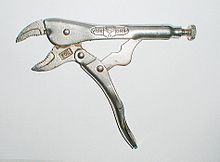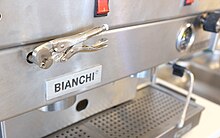Locking pliers

Locking pliers (or Vise-Grips or a Mole wrench or a vice grip) are pliers that can be locked into position, using an over-center toggle action.
History

The first locking pliers, named Vise-Grips, were invented by William S. Petersen in De Witt, Nebraska in 1924.[1]
In 1955 "Mole wrenches" were developed by Thomas Coughtrie (1917–2008), who was at that time managing director of M. K. Mole and Son.[2] The wrenches were manufactured in Newport, Wales, just off the M4, near to the Brynglas Tunnels; travelling west on the motorway, the Mole sign was visible immediately before entering the tunnels.
Mechanism
The principal mechanism of locking pliers is the over-centre clamp. When the pliers are closed on an object, the mechanism passes through a point of tightest clamping and as the handle levers are closed further, the jaws release slightly. The inherent flexibility of the pliers maintains a spring pressure on the jaws such that the handle needs to be pulled open to release the clamping pressure. Thus the pliers will safely remain clamped on the object without requiring continuous pressure on the handle levers. One side of the handle of locking pliers includes a bolt that is used to adjust the spacing of the jaws, the other side of the handle (especially in larger models) often includes a lever to push the two sides of the handles apart to unlock the pliers. "Mole" and "Vise-Grip" are trade names of different brands of locking pliers, yet mechanics and do-it-yourself hobbyists and craftspeople generically refer to locking pliers as "Vise-Grips" in the US, and "Mole grips" in the UK. In Ireland the tool is known as a "vice grip".
Locking pliers are available in many different configurations, such as needle-nose locking pliers, locking wrenches, locking clamps and various shapes to fix metal parts for welding. They also come in many sizes.
Operation

The bolt is used to set the jaws to a size slightly smaller than what is to be gripped. The jaws are then closed on the gripped object.
Because of the lever action the jaws move only slightly but with much force. Locking pliers have four advantages:
- Their lever action is stronger than that of ordinary pliers, so they can apply much more force;
- Even though they can apply more force, they do so in a very controlled manner; this is because the jaws will never close beyond the set point;
- The closing point and with it the force that is applied on the gripped object can be finely controlled;
- When they are closed they remain closed on their own without any user intervention.
A typical use would be to hold metal parts in place for welding. They are also used for holding a nut or bolt that has been 'rounded'; pulling out nails; holding pipes without squeezing them; or as temporary levers/knobs on equipment and machinery.
References
- ^ "Petersen Manufacturing". Official Nebraska Government Website. Retrieved 2012-03-21.
- ^ [1]
External links
- History of the Vise-Grip
- "New Tool Is Both Pliers and Wrench" Popular Science, December 1935, page 42
- "Wrench with Vise Like Grip Keeps Work from Slipping", Popular Mechanics, September 1935, page 326
